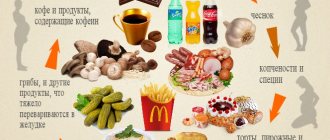Quite often, many people experience unpleasant sensations: a burning sensation behind the sternum, a feeling of a “lump” in the throat, excessive mucus formation in the larynx, belching air or sour, but many do not pay any attention to this.
Sometimes they take heartburn medications on their own on the advice of friends, pharmacists in pharmacies, or from a home medicine cabinet. In fact, sometimes these manifestations are associated with eating poor quality food, alcohol, or simply overeating. But heartburn can be a manifestation, and sometimes the only sign, of serious diseases of the gastrointestinal tract. Diseases of the esophagus and stomach - esophagitis, reflux esophagitis, gastroesophageal reflux disease, gastric and duodenal ulcers, gallbladder diseases; chronic cholecystitis, cholelithiasis, heartburn is also common during pregnancy and in operated patients.
Cause of heartburn
Most cases of occurrence are associated with the effect of gastric juice on the esophageal mucosa. Such an effect becomes possible when gastric contents reflux into the esophagus (gastroesophageal reflux), and this in turn becomes possible due to insufficiency of the cardiac sphincter of the esophagus (a kind of clamp at the junction of the esophagus with the stomach), which normally separates the acidic contents of the stomach. Severe reflux (reflux) leads to the appearance of the disease reflux esophagitis - this is inflammation of the esophageal mucosa under the influence of gastric juice. With prolonged exposure, an inflammatory process occurs in the esophagus, erosions and even ulcerative lesions may appear, while the patient’s condition remains the same complaint - heartburn, although the process is at a completely different stage.
Dyspepsia of alimentary origin
The occurrence of dyspeptic disorders against the background of excessive consumption of foods rich in carbohydrates is associated with fermentation processes. They arise in situations where the principles of rational nutrition are violated not occasionally, but systematically.
Fermentative dyspepsia often occurs in people with a sweet tooth. Mostly these are children. It is quite difficult for them to give up sweet flour products. The same applies to persons with obesity of alimentary-constitutional origin.
Dyspepsia of alimentary origin develops against the background of poor nutrition
If there is an excess of carbohydrate component in the diet in the stomach and intestines, this type of nutrients undergoes a longer digestion process. Chemical prerequisites are created for the development of the fermentation process.
As a result, the contents in the lumen of the digestive organs become osmotically active. This leads to the appearance of diarrhea syndrome. Reflexively, the intestinal chyme causes sour heartburn and pain in the epigastrium or xiphoid process of the sternum.
Diseases that may cause heartburn
Gastroesophageal reflux disease and reflux esophagitis. Hiatal hernia. Frequent increases in pressure in the abdominal cavity, caused by heavy physical activity, coughing, constipation, and overeating, gradually lead to a weakening of the muscular apparatus, which takes part in fixing the esophagus and stomach in the abdominal cavity. With a hiatal hernia, the cardia closure mechanism is often disrupted, i.e. valve, which is located between the esophagus and the stomach, resulting in the reflux of gastric contents into the esophagus. Hence the sensations that a person experiences - these are, first of all, heartburn, belching, regurgitation of food, pain behind the sternum, often simulating heart pain; these manifestations can intensify in a horizontal position, when bending the body forward, wearing a corset.
The constant reflux of gastric contents into the esophagus inevitably leads to chronic inflammation of the mucous membrane of the esophagus, resulting in so-called peptic esophagitis, which in turn can progress to the formation of ulcers and cancer of the esophagus (unless, of course, it is not treated in a timely manner).
Peptic ulcer of the stomach and duodenum
Heartburn with peptic ulcers develops for several reasons.
- First, very often in patients with peptic ulcers there is increased acidity of gastric juice, and even short episodes of reflux into the esophagus cause a significant damaging effect on the esophageal mucosa, and therefore cause heartburn.
- Secondly, when an ulcer affects the wall of the stomach or duodenum, their contractile function decreases, the time for food to pass through the stomach and duodenum increases several times. As a result, the number of episodes of reflux of gastric contents into the esophagus increases. Third, with a complicated course of peptic ulcer, with the development of stenosis (narrowing) of the duodenum, stagnation of food in the stomach develops. Food cannot leave the stomach in a timely manner. Such patients develop belching of food eaten the day before, and in advanced cases, vomiting.
Diseases of the gallbladder and bile ducts - disruption of the process of bile secretion, dyskinesia (stagnation of bile in the bladder and ducts) leads to inadequate release of bile into the duodenum, delay in the movement of food through it, as a result, increased pressure in the intestinal lumen and reflux of bile into the stomach, these processes cause inflammation of the gastric mucosa - gastritis, then reflux of acidic contents into the esophagus occurs, as a manifestation of gastritis.
In addition to the above pathology, heartburn can be a symptom of any other diseases if they somehow affect the gastrointestinal tract. Heartburn is often observed with systemic connective tissue diseases, for example with lupus erythematosus and systemic scleroderma. It occurs against a background of decreased appetite, weight loss, weakness, and fever.
Flour-based products
Flour products include not only confectionery products. They include pasta, spaghetti, bread, crackers. Regarding pasta, it should be remembered that products based on soft wheat flour are more likely to develop dyspeptic symptoms. Including heartburn.
Biscuits and cakes are a separate group of flour products that belong to baking. These foods have a high glycemic index. In patients with diabetes mellitus, they increase the risk of hyperglycemia and the development of gastrostasis. This is especially typical for elderly patients.
Homemade baked goods, as well as pies and pies made in bakeries or canteens, have different compositions. The composition of the dough and the oil in which they are baked or fried play a big role.
Baking often causes functional dyspepsia of non-ulcer origin.
It is caused by the fact that excess carbohydrates become a favorable environment for the proliferation of fermentative flora.
Heartburn in healthy people
In some cases, heartburn can occur in people who do not suffer from diseases of the gastrointestinal tract. For example, it often appears when certain medications are taken orally. First of all, this is a group of non-steroidal anti-inflammatory drugs (for example, the well-known aspirin, paracetamol, ketonal, diclofenac and others). A significant number of people experience heartburn after eating refined carbohydrate foods (flour, sweets, fresh baked goods, jelly). After restoring the nutritional balance and normalizing the diet, heartburn ceases to bother these individuals.
Treatment approaches
The most important aspect of treating any disease of the gastrointestinal tract is following dietary recommendations. Pastries, pasta, white bread, cakes, gingerbreads and rolls should be avoided.
If you have gastritis, gastric or duodenal ulcers, you should take antisecretory drugs. They reduce acid formation, thereby reducing the symptoms of heartburn in particular, as well as inflammatory processes of the mucous membrane in general.
Antibacterial agents are indicated as part of the eradication of Helicobacter pylori. The course of treatment is up to 2 weeks. After this, a control FEGDS is performed.
For gastroesophageal reflux disease, the use of prokinetics is justified. Metoclopramide courses are effective.
Treatment using traditional medicine is possible. In the absence of allergic reactions to herbs, you can use decoctions or teas based on chamomile and yarrow herb. But it is better to agree on the possibility of such treatment with your doctor.
Heartburn in pregnant women
A growing uterus leads to increased intra-abdominal pressure. As a result, the cardiac sphincter does not close tightly enough and the contents of the stomach are thrown back into the esophagus, so heartburn begins to bother the pregnant woman from about 20-22 weeks, however, it occurs periodically and may be a manifestation of the increased sensitivity of the expectant mother’s body to various nutrients. From the 30th week, about 1/3 of all pregnant women complain of frequent heartburn, and by the 38th week their number increases to 99%. The cause of heartburn during pregnancy is also toxicosis, with frequent vomiting and, consequently, irritation of the esophagus with vomit, as well as temporary functional failure of the cardiac part of the stomach in the second half of pregnancy.
Prevention
If you discover heartburn, you first need to understand what food causes it and try to eliminate it from your diet. It is very important not to overeat. To do this, you need to give up large portions, eat more often, but less, do not overeat before bed, and limit your coffee consumption. Pregnant women should consult a doctor to choose a safe drug to relieve symptoms and be sure to follow a diet. If heartburn occurs frequently (daily, weekly, after physical work or night shifts) or is accompanied by belching and abdominal pain, you should definitely consult a doctor.
Treatment of heartburn
Aimed at eliminating the cause of heartburn, treatment is always comprehensive and includes following a diet (selected taking into account the acidity of gastric juice and concomitant diseases), prescribing drugs that reduce the production of hydrochloric acid, drugs that regulate contractions of the esophagus, stomach and intestines, enveloping drugs and the use of medicinal herbs and fees.
A very important point - with long-term heartburn and the patient’s failure to treat it, it wastes precious time and triggers irreversible changes in the mucous membrane of the esophagus and stomach, thereby worsening the prognosis. Treatment started in a timely manner helps to completely rid the patient of the problem or achieve a stable course!
Effect of components on the body
Industrially produced bread, as well as any flour products, cause heartburn. They consist (mostly) of carbohydrates and unhealthy fats, which slow down your metabolism and lead to obesity. Flour products contain products that provoke severe heartburn:
- Refined flour. The use of the white component gives the bread a beautiful shape, a pronounced taste, and an appetizing shade (especially for the baked crust). The refined product contains a lot of gluten, which can cause heartburn. Flour is produced from modified wheat (up to 70% of all raw materials).
If the ingredient is abused, healthy people develop celiac disease - gluten intolerance. Against this background, stomach pain, bloating, and heartburn appear. Long-term exposure to gluten on the body leads to dystrophy of the small intestine - its villi are reduced, microbes multiply, and rotting processes are started.
- Yeast and sourdough. Home baking often uses dough based on hops and malt, which was used by people 1-2 thousand years ago. The industry uses synthetic yeast from low-quality raw materials, or natural starters based on waste from corn, cotton and cellulose. Chemical compounds are used to process them. Thermophilic yeast remains active even when heated to 200 degrees. Inside the intestines, thermophilic fungi cause gas formation, fermentation, and lead to calcium deficiency. With long-term consumption of foods with a high yeast content, constipation, intoxication, and heartburn from flour occur.
Yeast provokes the proliferation of harmful bacteria, which is fraught with dysbacteriosis and tumor processes. If you eat bread in small quantities, then yeast activity is not observed in the body.
- Animal fats. Butter, cream and milk can cause fermentation in the intestines and lead to heartburn from flour. They are poorly absorbed and at high concentrations often lead to pain and bloating. If a person is diagnosed with gastritis, then these products are contraindicated. The situation is even worse with vegetable, modified fats.
Additional components that cause heartburn
The cause of heartburn from baked flour products may be due to the presence of other components:
- sugar, sweet substitutes, honey - irritate the esophagus, sphincters and stomach, especially if there is high acidity in the body;
- baking powder – if consumed in excess, it weakens the muscles of organs;
- soda - acts on the principle of acid rebound, increasing the production of gastric juice some time after consumption.
A large number of seeds and nuts in baked goods in combination with dried fruits, white flour, animal fats and sugar loads the liver and pancreas.
Hidden enemy - bran
The food industry uses the properties of some products to its advantage, but in fact uses so few useful components that all advertising gimmicks turn out to be untenable.
Fact! Bran is a healthy dietary fiber that helps digestion and does not cause heartburn. But in baking they are used only 8-10%, with recommended rates of 30%.
Bran spoils the condition of whole grain flour, reducing its shelf life by almost 2 times, which is not beneficial for manufacturers. Therefore, a useful concentration of dietary fiber cannot be found in industrial flour products.
Heartburn from salt
It is impossible to completely give up salt, but excessive consumption leads to heartburn. In industrial flour products, the amount of salt is unreasonably high. Salt provokes the production of gastric juice, which is thrown into the esophagus and causes a strong burning sensation.









